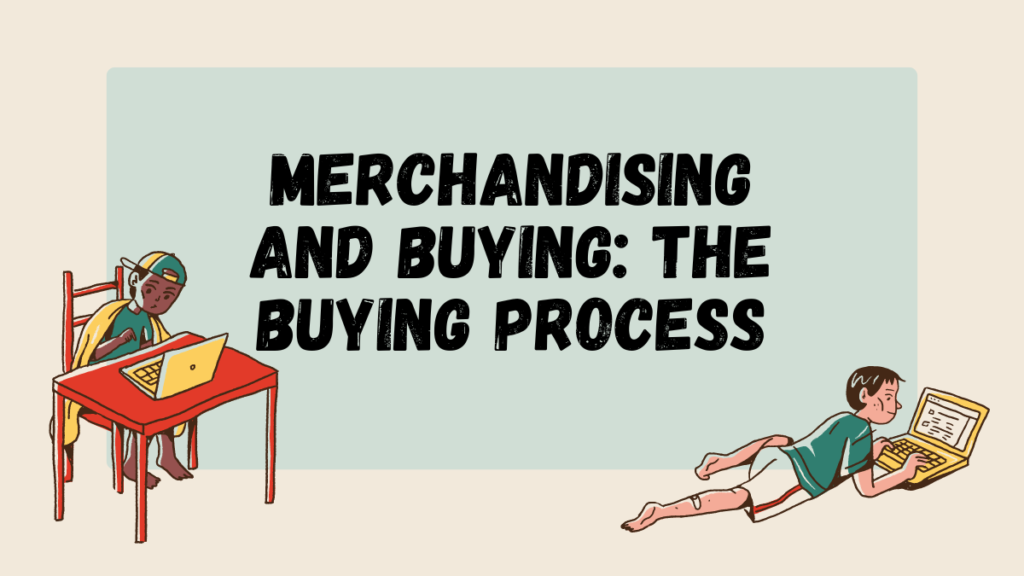Merchandising and Buying: Unique Guide

Merchandising and Buying: involves the selection and presentation of products in a way that maximizes sales. Buying refers to the procurement of these products from suppliers. Together, they form the backbone of retail operations, ensuring that consumer demand is met efficiently and effectively.
Merchandising and Buying: The Importance of Merchandising in Retail

Merchandising and Buying drives sales by appealing to customers’ senses and influencing their purchasing decisions. Effective merchandising enhances the shopping experience, leading to increased customer satisfaction and loyalty.
Types of Merchandising
Visual Merchandising
Visual merchandising focuses on the aesthetics of product presentation. It involves the strategic arrangement of products, signage, lighting, and displays to attract and engage customers.
Product Merchandising
Product Merchandising and Buying deals with the assortment and availability of products. It ensures that the right mix of products is available to meet consumer demand and maximize sales.
Merchandising and Buying: Digital Merchandising
Digital merchandising applies merchandising principles to online retail platforms. It involves optimizing product listings, using high-quality images, and ensuring seamless navigation to enhance the online shopping experience.
Merchandising and Buying: The Buying Process

Market Research
Market research is the first step in the buying process. It involves analyzing market trends, consumer preferences, and competitive landscapes to identify potential products and suppliers. “Merchandising and Buying”
Supplier Selection
Selecting the right suppliers is crucial for ensuring product quality and reliability. Buyers evaluate suppliers based on criteria such as price, quality, delivery times, and reputation.
Merchandising and Buying: Negotiation
Negotiation with suppliers is a key skill for buyers. Effective negotiation can lead to better prices, favorable terms, and long-term partnerships.
Purchase Order Management
Merchandising and Buying purchase orders involves tracking and controlling orders from suppliers to ensure timely and accurate delivery of products.
Key Roles in Merchandising and Buying
Merchandisers
Merchandisers plan and execute merchandising strategies to drive sales. They analyze sales data, forecast demand, and coordinate with other departments to optimize product presentation and inventory levels.
Buyers
Buyers are responsible for sourcing and purchasing products. They conduct market research, select suppliers, negotiate terms, and manage purchase orders.
Merchandising and Buying: Planners
Planners work closely with merchandisers and buyers to develop sales forecasts, inventory plans, and replenishment strategies. They use data analysis to ensure optimal product availability and minimize stockouts and overstocks. “Merchandising and Buying”
Merchandising Strategies
Assortment Planning
Assortment planning involves selecting the right mix of products to meet consumer demand. It considers factors such as product variety, price points, and seasonal trends.
Pricing Strategies
Pricing strategies are critical for maximizing sales and profitability. Merchandising and Buying use various pricing tactics, such as competitive pricing, discounting, and value-based pricing, to attract customers and drive sales.
Inventory Management
Viable stock administration guarantees that items are accessible when and where they are required. It involves balancing inventory levels to avoid stockouts and overstocks, and optimizing the supply chain to reduce costs.
Technological Impact on Merchandising and Buying

E-commerce Integration
E-commerce integration has transformed merchandising and buying by enabling real-time inventory tracking, personalized marketing, and seamless shopping experiences across online and offline channels.
Merchandising and Buying: Data Analytics
Data analytics plays a crucial role in merchandising & buying. It helps retailers analyze sales data, forecast demand, and optimize product assortments and pricing strategies.
AI and Machine Learning
AI and machine learning technologies are revolutionizing merchandising and buying. They enable retailers to automate tasks, personalize customer experiences, and make data-driven decisions.
Challenges in Merchandising and Buying
Inventory Overstocks and Stockouts
Managing inventory levels is a constant challenge. Overstocks tie up capital and increase storage costs, while stockouts lead to missed sales opportunities and dissatisfied customers.
Changing Consumer Preferences
Consumer preferences are constantly evolving, making it difficult to predict demand and select the right products. Retailers must stay agile and responsive to market trends.
Supplier Reliability
Ensuring supplier reliability is critical for maintaining product quality and availability. Retailers need to establish strong relationships with suppliers and have contingency plans in place for potential disruptions.
Latest Trends in Merchandising and Buying
Sustainability
Sustainability is becoming increasingly important in merchandising and buying. Consumers are demanding eco-friendly products and transparent supply chains, prompting retailers to adopt sustainable practices.
Personalization
Personalization is a key trend in merchandising and buying. Retailers are using data analytics and AI to offer personalized product recommendations and tailored shopping experiences.
Omnichannel Retailing
Omnichannel retailing involves providing a seamless shopping experience across multiple channels, including online, in-store, and mobile. It requires integrating inventory, marketing, and customer service systems to ensure consistency and convenience.
Case Studies
Successful Merchandising Strategies
Examining successful merchandising strategies from leading retailers can provide valuable insights. For example, Apple’s minimalist store design and product displays create a premium shopping experience that drives sales.
Innovative Buying Approaches
Innovative buying approaches, such as Zara’s fast fashion model, highlight the importance of agility and responsiveness in the buying process. Zara’s ability to quickly bring new products to market gives it a competitive edge.
Merchandising and Buying: Expert Insights
Quotes from Industry Leaders
Industry leaders provide valuable insights into merchandising and buying best practices. For example, former Amazon CEO Jeff Bezos emphasized the importance of customer focus and data-driven decision-making.
Merchandising and Buying: Best Practices
Best practices in merchandising and buying include leveraging technology, fostering supplier relationships, and continuously analyzing market trends to stay ahead of the competition.
Future of Merchandising and Buying
Emerging Technologies
Emerging technologies, such as blockchain for supply chain transparency and virtual reality for immersive shopping experiences, are set to transform merchandising & buying.
Merchandising and Buying: Predicted Market Changes
Predicted market changes include the continued growth of e-commerce, increased emphasis on sustainability, and the rise of direct-to-consumer brands.
Conclusion
Merchandising and buying are dynamic and essential functions in the retail industry. By understanding and implementing effective strategies, retailers can enhance their operations, meet consumer demand, and drive business success.
FAQs
What is merchandising in retail?
Merchandising in retail involves the selection, presentation, and promotion of products to maximize sales and enhance the shopping experience.
What does a buyer do?
A buyer is responsible for sourcing and purchasing products. They conduct market research, select suppliers, negotiate terms, and manage purchase orders.
Why is inventory management important?
Inventory management ensures that products are available when and where they are needed. It helps avoid stockouts and overstocks, optimizing costs and improving customer satisfaction.
How does technology impact merchandising & buying?
Technology, such as data analytics and AI, enables retailers to make data-driven decisions, automate tasks, and personalize customer experiences. E-commerce integration has also transformed inventory management and marketing.
What are the latest trends in merchandising and buying?
Latest trends include sustainability, personalization, and omnichannel retailing. Retailers are adopting eco-friendly practices, using data for personalized experiences, and providing seamless shopping across multiple channels.
How can retailers stay ahead in merchandising & buying?
Retailers can stay ahead by leveraging technology, fostering strong supplier relationships, continuously analyzing market trends, and being responsive to changing consumer preferences.
What challenges do retailers face in merchandising & buying?
Challenges include managing inventory levels, predicting consumer preferences, and ensuring supplier reliability. Retailers need to be agile and proactive to address these issues effectively.
What is the future of merchandising and buying?
The future involves the adoption of emerging technologies like blockchain and virtual reality, a greater emphasis on sustainability, and the continued growth of e-commerce and direct-to-consumer brands.
Read More: How to Install and Watch USTVNow





